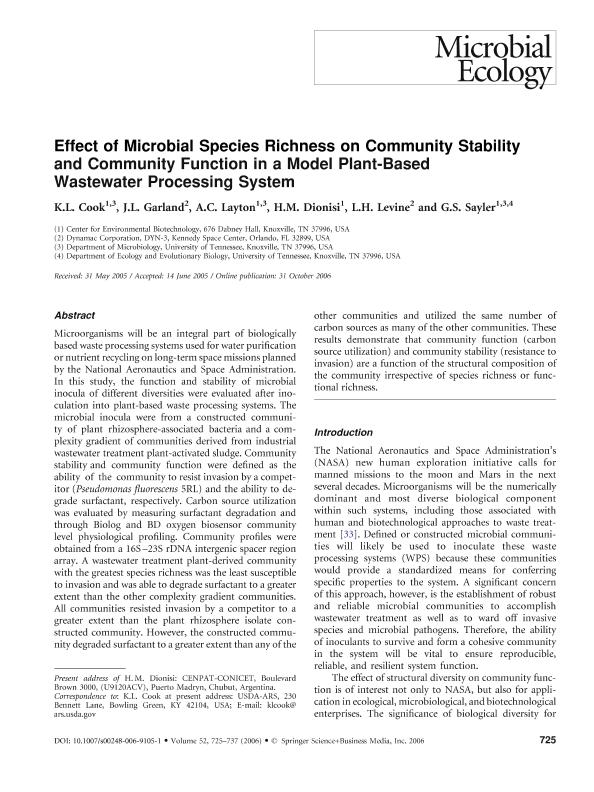Mostrar el registro sencillo del ítem
dc.contributor.author
Cook, K. l.
dc.contributor.author
Garland, J. L.
dc.contributor.author
Layton, A. C.
dc.contributor.author
Dionisi, Hebe Monica

dc.contributor.author
Levine, L. H.
dc.contributor.author
Sayler, G. S.
dc.date.available
2017-05-26T21:30:03Z
dc.date.issued
2006-10-31
dc.identifier.citation
Cook, K. l.; Garland, J. L.; Layton, A. C.; Dionisi, Hebe Monica; Levine, L. H.; et al.; Effect of Microbial Species Richness on Community Stability and Community Function in a Model Plant-Based Wastewater Processing System; Springer; Microbial Ecology; 52; 4; 31-10-2006; 725-737
dc.identifier.issn
0095-3628
dc.identifier.uri
http://hdl.handle.net/11336/17020
dc.description.abstract
Microorganisms will be an integral part of biologically based waste processing systems used for water purification or nutrient recycling on long-term space missions planned by the National Aeronautics and Space Administration. In this study, the function and stability of microbial inocula of different diversities were evaluated after ino- culation into plant-based waste processing systems. The microbial inocula were from a constructed communi- ty of plant rhizosphere-associated bacteria and a com- plexity gradient of communities derived from industrial wastewater treatment plant-activated sludge. Community stability and community function were defined as the ability of the community to resist invasion by a compet- itor ( Pseudomonas fluorescens 5RL) and the ability to de- grade surfactant, respectively. Carbon source utilization was evaluated by measuring surfactant degradation and through Biolog and BD oxygen biosensor community level physiological profiling. Community profiles were obtained from a 16S –23S rDNA intergenic spacer region array. A wastewater treatment plant-derived community with the greatest species richness was the least susceptible to invasion and was able to degrade surfactant to a greater extent than the other complexity gradient communities. All communities resisted invasion by a competitor to a greater extent than the plant rhizosphere isolate con- structed community. However, the constructed commu- nity degraded surfactant to a greater extent than any of the other communities and utilized the same number of carbon sources as many of the other communities. These results demonstrate that community function (carbon source utilization) and community stability (resistance to invasion) are a function of the structural composition of the community irrespective of species richness or func- tional richness.
dc.format
application/pdf
dc.language.iso
eng
dc.publisher
Springer

dc.rights
info:eu-repo/semantics/openAccess
dc.rights.uri
https://creativecommons.org/licenses/by-nc-sa/2.5/ar/
dc.subject
Species Diversity
dc.subject
Consortium
dc.subject
Graywater
dc.subject
Clpp
dc.subject
Wastewater
dc.subject
Array
dc.subject.classification
Biología Celular, Microbiología

dc.subject.classification
Ciencias Biológicas

dc.subject.classification
CIENCIAS NATURALES Y EXACTAS

dc.title
Effect of Microbial Species Richness on Community Stability and Community Function in a Model Plant-Based Wastewater Processing System
dc.type
info:eu-repo/semantics/article
dc.type
info:ar-repo/semantics/artículo
dc.type
info:eu-repo/semantics/publishedVersion
dc.date.updated
2017-05-17T13:52:18Z
dc.journal.volume
52
dc.journal.number
4
dc.journal.pagination
725-737
dc.journal.pais
Alemania

dc.journal.ciudad
Nueva York
dc.description.fil
Fil: Cook, K. l.. Center for Environmental Biotechnology; Estados Unidos. University Of Tennessee; Estados Unidos
dc.description.fil
Fil: Garland, J. L.. Kennedy Space Center. DYN-3. Dynamac Corporation; Estados Unidos
dc.description.fil
Fil: Layton, A. C.. Center for Environmental Biotechnology; Estados Unidos. University Of Tennessee; Estados Unidos
dc.description.fil
Fil: Dionisi, Hebe Monica. Center for Environmental Biotechnology; Estados Unidos. Consejo Nacional de Investigaciones Científicas y Técnicas. Centro Nacional Patagónico; Argentina
dc.description.fil
Fil: Levine, L. H.. Kennedy Space Center. DYN-3. Dynamac Corporation; Estados Unidos
dc.description.fil
Fil: Sayler, G. S.. Center for Environmental Biotechnology; Estados Unidos. University Of Tennessee; Estados Unidos. University of Tennessee. Department of Ecology and Evolutionary Biology; Estados Unidos
dc.journal.title
Microbial Ecology

dc.relation.alternativeid
info:eu-repo/semantics/altIdentifier/doi/http://dx.doi.org/10.1007/s00248-006-9105-1
dc.relation.alternativeid
info:eu-repo/semantics/altIdentifier/url/http://link.springer.com/article/10.1007/s00248-006-9105-1
Archivos asociados
